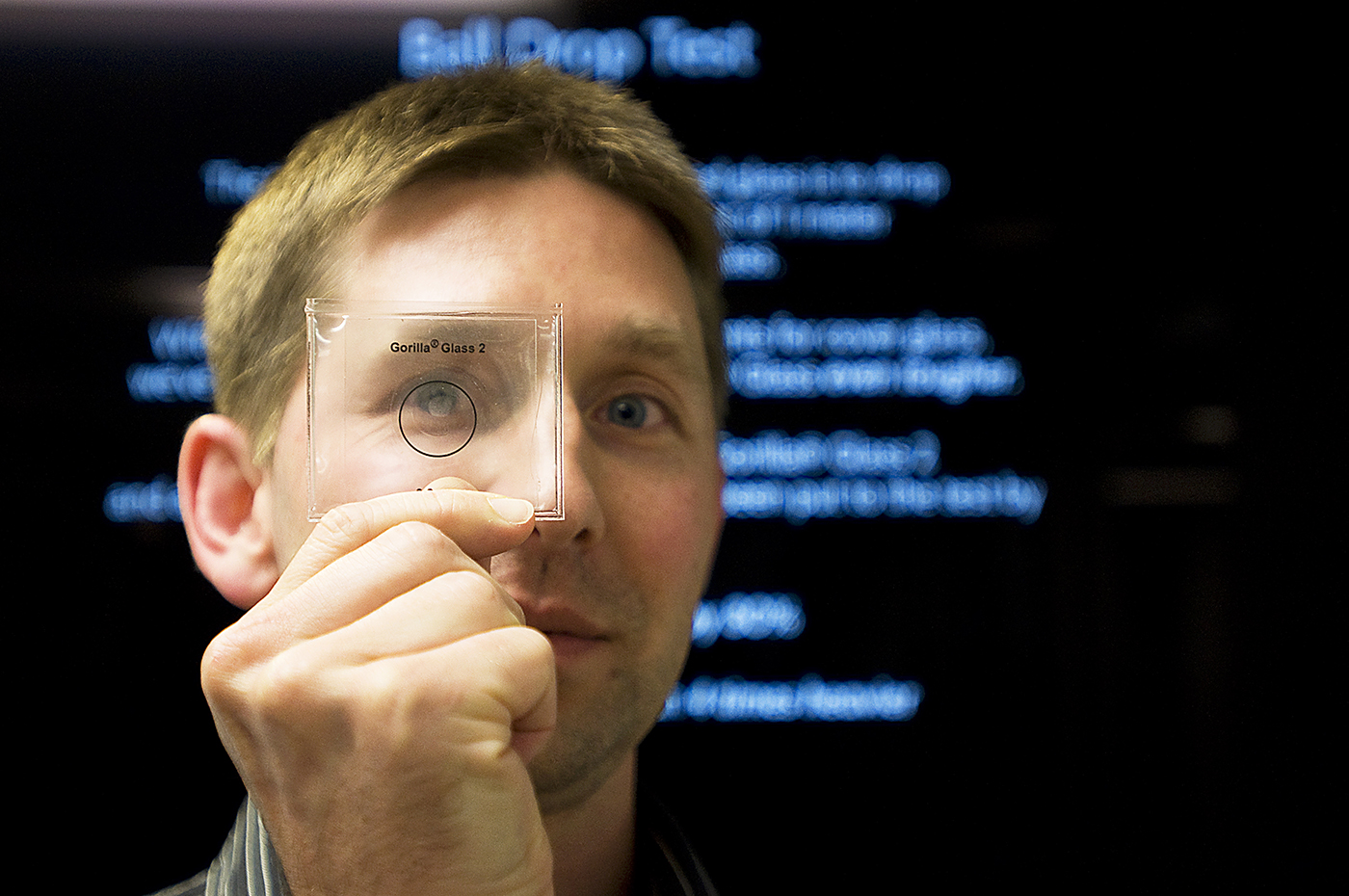Touching technology
Touching technology

By JEFFREY BLACKWELL/STAFF WRITER
(Published Democrat & Chronicle August 2012)
Rise in the morning and touch the glass surface of a 100-inch flat-screen television on the wall for the daily schedule, emails, news and weather before walking into the bathroom to brush your teeth and respond to an instant message that pops-up on the mirror.
In the kitchen, your spouse cracks eggs into a bowl on a white glass counter and with a touch of an index finger turns on the stove as an interactive screen tunes on the morning news.
It’s futurama, a home where touch-screen displays, universal connectivity and instant access are pieced together in a new world of interactive consumer products.
Seems like a bit much? Perhaps not. A well-known company has already done the work in video — and it’s not Apple or Microsoft, but a 161-year-old glass company in Corning, Steuben County, Corning Inc.
The YouTube video is called “A Day Made of Glass” and has received more than 19.6 million hits since its 2011 release. The reason for the popularity seems to be in the video’s look into a future, that in the time of hand-held smartphones and tablets and high-definition flat-screen televisions the size of a wall, is all too easy to believe with a little help.
“Corning has really made its history — 161 years — looking at the intersection of technology in organic materials and big trends that affect society,” said John Bayne, vice president and general manager of High Performance Displays, Corning Glass Technologies. “So the intent of that video is to demonstrate our view of how things could evolve in the future and the role Corning could play.”
Corning Inc. did more than $6.6 billion in sales last year and has more than 29,000 employees world-wide, including a Corning Tropel unit in Fairport. Tropel manufactures laser-based instruments that measure flatness, parallelism, depth, height and thickness of machined parts.
Innovation and Gorilla Glass Corning’s Display Technologies unit is the company’s leading revenue segment, accounting for more than 26 percent of sales in 2011. It’s the division featured in the viral video.
And one of the products leading the way is Corning’s Gorilla Glass line, a high-strength, flexible and thin sheet glass used in many hand-held devices as a protective, touch-sensitive cover that is durable and scratch resistant.
“Gorilla Glass has been an amazing story for Corning since we launched it in 2007,” said David Velasquez, a director of marketing and commercial operations. “Some of this was based on older technology and some of this is brand new discoveries we made in the lab … we had this explosion of smartphones and touch enabled devices and as touch grew on these devices, glass followed.”
A secret compound is poured into a trough and allowed to run over both sides to rejoin and create fused glass. The hot sheets of glass are not allowed to touch rollers or anything else that could create irregularities in the surface. The continuous sheet of glass is then put in a solution, which provides its strength and flexibility.
What’s different in this process, other that the glass compound, is that this thin glass is created without grinding or polishing, which is common in the industry.
The result is a surface that is extremely smooth and flat with great dimensional stability and uniform thickness. Those traits make the glass ideal for LCD technology found in today’s flat screen televisions, computer screens and hand-held devices. It is also the inspiration behind the video, how a highly interactive display glass could create a world of connectivity.
“What they needed was a pristine surface of glass because they were putting, at the time, thousands of transistors and now millions of transistors, semiconductor electronics, on the glass so the surface of the glass had to be pristine and the dimensional tolerances had to be very good,” said Bayne. “So basically all your liquid crystal TVs and monitors and notebooks were made with this technology.”
Long-term goals vs. Wall Street’s expectations
Technology and innovation is at the center of Corning’s history and many rebirths. In March, Forbes Magazine contributing writer Philip McKinney, listed Corning CEO Wendell Weeks and one of three CEO’s “who get innovation.” The other two leaders on the list included Jeffrey Katzenberg, CEO of DreamWorks Animation, and Paul Jacobs, CEO and chairman of Qualcomm.
“Wendell exudes passion for his products, his company and its ability to innovate,” McKinney wrote. “Give me a CEO with passion for ideas and innovation and I will show you a company that will consistently win against their competition.”
And according to an account in the 2011 biography of Apple’s Steve Jobs, by Walter Isaascon, Jobs recounts a meeting with Weeks before the introduction of the iPhone.
Jobs, according to the book, was not happy with the prototype because his keys scratched the glass display. Weeks told Jobs, according to the book, Corning could make a glass that was durable and scratch resistant from a process developed in the 1960 for vehicle windshields. And that meeting was the seed for the development of Gorilla Glass.
Corning has remade itself many times based on changing technology and its own research and development center, Sullivan Park.
The company spends about 10 percent of its global revenue on research, development and engineering. Corning consistently ranks in the top tier of industrial companies receiving patents too. In 2011, it held more than 4,300 unexpired patents, more than half of which were issued in the U.S.
“We are not a glass company or a telecommunications company or an environmental science company — we are a technology company,” said Bayne. “Corning is a unique company, we make long-term technology bets looking at at this intersection of glass and inorganic material with technology trends and society trends and sometimes that message is hard to explain to Wall Street because they are so focused on quarterly results, so the intent of the video was to explain to our investors and the community how Corning looks long-term in the future.”
Corning stock has been on the upswing from falling prices over the past year. First quarter sales $1.9 billion were essentially flat from the first quarter of 2011. And after expenses, Corning had profits of $462 million or 30 cents per share, a decline of close to 37 percent from a year ago.
The reason is due to a down turn in display technology, especially LCD glass because of an oversupply in the market. Sales in such business lines as telecommunications, specialty materials and environmental technologies were up. Corning said it expects more moderate price declines the second quarter.
Technology and innovation is at the center of Corning’s history and many rebirths. In March, Forbes Magazine contributing writer Philip McKinney, listed Corning CEO Wendell Weeks and one of three CEO’s “who get innovation.” The other two leaders on the list included Jeffrey Katzenberg, CEO of DreamWorks Animation, and Paul Jacobs, CEO and chairman of Qualcomm.
“Wendell exudes passion for his products, his company and its ability to innovate,” McKinney wrote. “Give me a CEO with passion for ideas and innovation and I will show you a company that will consistently win against their competition.”
And according to an account in the 2011 biography of Apple’s Steve Jobs, by Walter Isaascon, Jobs recounts a meeting with Weeks before the introduction of the iPhone.
Jobs, according to the book, was not happy with the prototype because his keys scratched the glass display. Weeks told Jobs, according to the book, Corning could make a glass that was durable and scratch resistant from a process developed in the 1960 for vehicle windshields. And that meeting was the seed for the development of Gorilla Glass.
Corning has remade itself many times based on changing technology and its own research and development center, Sullivan Park.
The company spends about 10 percent of its global revenue on research, development and engineering. Corning consistently ranks in the top tier of industrial companies receiving patents too. In 2011, it held more than 4,300 unexpired patents, more than half of which were issued in the U.S.
“We are not a glass company or a telecommunications company or an environmental science company — we are a technology company,” said Bayne. “Corning is a unique company, we make long-term technology bets looking at at this intersection of glass and inorganic material with technology trends and society trends and sometimes that message is hard to explain to Wall Street because they are so focused on quarterly results, so the intent of the video was to explain to our investors and the community how Corning looks long-term in the future.”
Corning stock has been on the upswing from falling prices over the past year. First quarter sales $1.9 billion were essentially flat from the first quarter of 2011. And after expenses, Corning had profits of $462 million or 30 cents per share, a decline of close to 37 percent from a year ago.
The reason is due to a down turn in display technology, especially LCD glass because of an oversupply in the market. Sales in such business lines as telecommunications, specialty materials and environmental technologies were up. Corning said it expects more moderate price declines the second quarter.
The glass is ready; technology needs works
Surprisingly, much of the touch glass technology is ready to go now.
The company’s display and Gorilla Glass can be made into large sheets the size of walls or kitchen counters and can be shaped into the kind of curves needed for vehicle dashboards, appliances and architectural designs.
What is lacking for much of this technology is the fiber optic and digital infrastructure to support that level of bandwidth demand and the level of advanced electronics to power and make those gadgets and innovations possible, at least for now.
Karl Hirschman, professor of Microelectronic Engineering at the Rochester Institute of Technology, has worked with Corning on integrating electronics with a display glass. He said the company has come a long way in the development and use of display glass and that the video is an interesting look into the future.
“The videos are neat and each of those things you see individually would be not be too unrealistic or too far out there,” he said. “It’s something that could be out there, that could be attainable at some point with a lot of integrated electronics with the glass materials, and things are more heading in that direction, where they are doing a lot more integrating electronics on the glass.”
Joshua Jacobs is the manager of Corning’s North American Laboratory Product Performance and Reliability, Special Materials Development. His team gets to test the strength and usability of Gorilla Glass by dropping steel balls on it, piercing it with a diamond and finding other ways to scratch the glass with a machine.
They even have a pitching machine that throws baseballs at the glass. He said the glass is tough, but everything eventually has its breaking point.
What he does see in the glass is a future and opportunity to for his and work of his colleagues at Corning to help make the video become reality with the help of other companies and innovators.
“Something we do well is helping people envision what they can do with glass,” he said. “That is what the video was all about. A lot of people think of glass as being very brittle, very weak and people do not always realize what they can do with the material.”
























